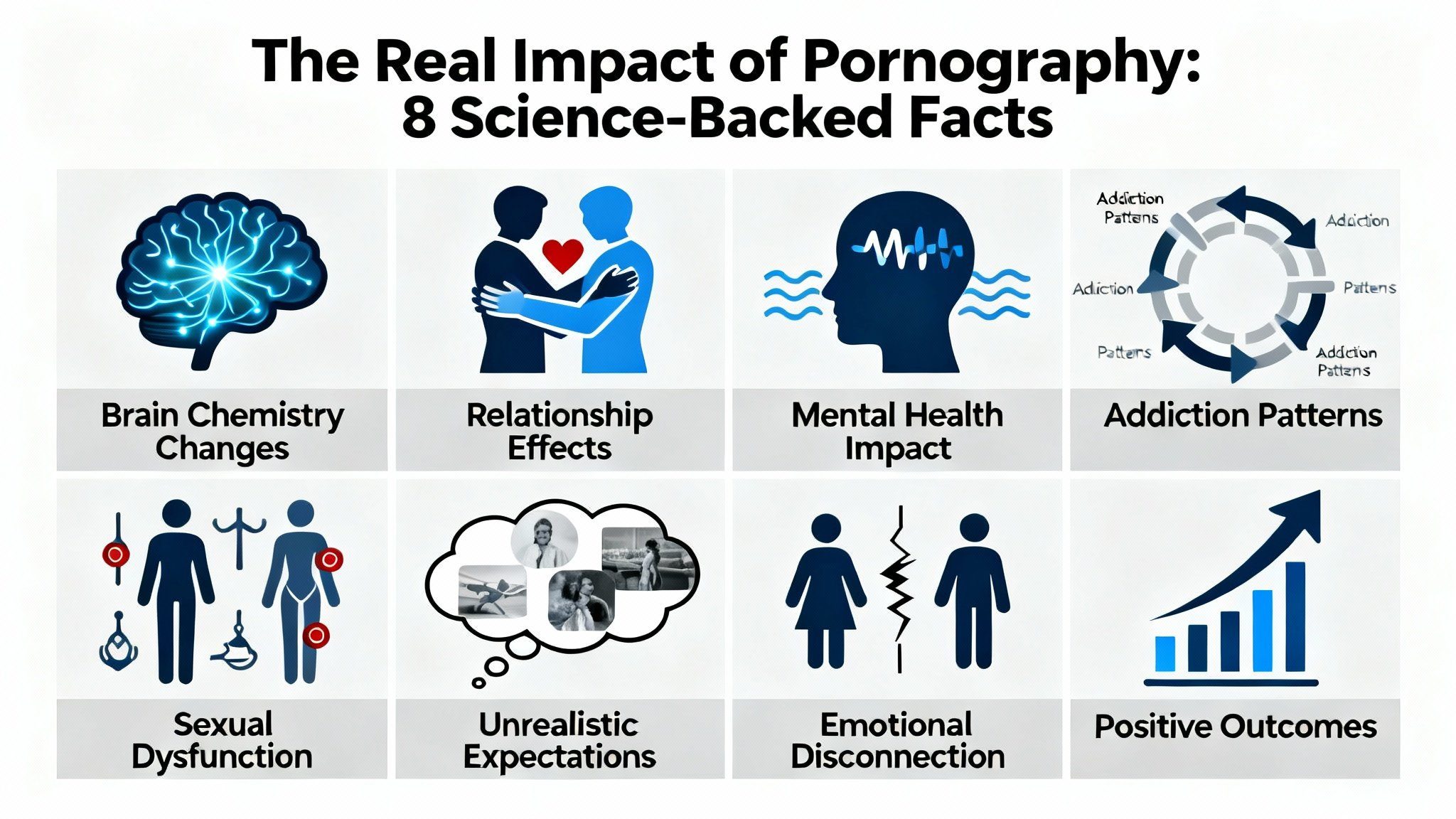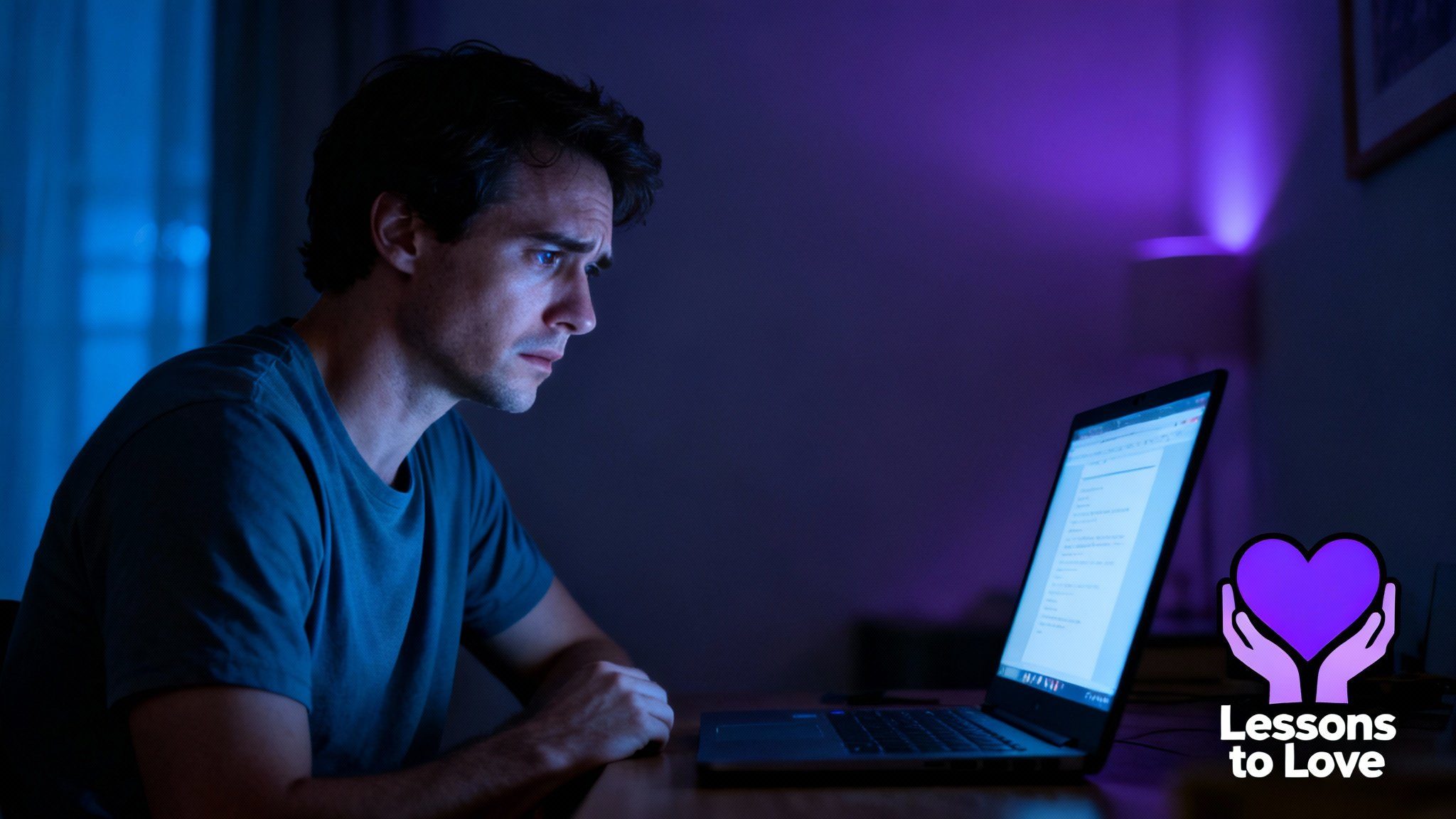The Impact of Pornography on Sexual Health: What Science Actually Says (No Judgment, Just Truth)
Let’s get real.
Nobody wants to talk about pornography’s impact on sexual health. Not your doctor. Not your pastor. Not your therapist. And definitely not the multi-billion dollar industry profiting from your clicks.
But here’s what I know: you deserve the truth. Not the sanitized, politically correct version. Not the fear-mongering, shame-based propaganda. The actual, science-backed, uncomfortable truth about what pornography does to your brain, your relationships, and your sexual function.
This isn’t about judgment. I don’t care what you watch or how often you watch it. This is about giving you information so you can make informed decisions about your own sexual health and wellbeing.
Because here’s the thing: the impact is real. The research is clear. And pretending it doesn’t exist doesn’t make you free—it keeps you stuck.
So if you’re ready for an honest conversation about pornography and sexual health—one that respects your intelligence and doesn’t treat you like a child—keep reading.
What We’re Covering (No BS Edition)
- 🧠 What Is the Impact of Pornography on Mental Health?
- 💔 Impact of Porn on Relationships: The Uncomfortable Truth
- ⚠️ Pornography and Sexual Function: What the Research Shows
- 🤔 Why Is Pornography Considered Controversial?
- 🛠️ How to Manage Pornography Addiction: Real Solutions
- ✅ Can I Recover from Pornography? (Yes, Here’s How)
- 📚 How to Find Reliable Pornography Education Resources
- 🌱 Exploring Ethical Pornography: Is There Such a Thing?
- 👨👩👧 When to Discuss Pornography with Children
- 🔒 Where Can I Access Pornography Safely?
- ⚖️ What Are the Legal Issues Surrounding Pornography?
- ❓ FAQ: Your Questions Answered (No Judgment)
Let’s Get Real About Pornography and Sexual Health
Before we dive into the research, let’s establish something important: this conversation isn’t about morality. It’s about biology, psychology, and the measurable effects of pornography consumption on human sexual health.
Why This Conversation Matters
The average age of first pornography exposure is now 11 years old. By age 18, 93% of boys and 62% of girls have been exposed to online pornography. We’re talking about an entire generation whose sexual template is being shaped by content designed for arousal, not education.
And yet, we’re not talking about it. Not in schools. Not in homes. Not in doctor’s offices. The silence creates a vacuum where shame, misinformation, and confusion thrive.
This matters because pornography consumption isn’t neutral. It changes brain chemistry. It affects relationship dynamics. It influences sexual expectations and function. And for some people, it becomes a compulsive behavior that significantly impacts quality of life.
The Truth You Deserve to Know
Here’s what I’m not going to tell you: that pornography is inherently evil, that watching it makes you a bad person, or that you’re doomed if you’ve ever consumed it.
Here’s what I am going to tell you: what the research actually shows about pornography’s impact on mental health, relationships, and sexual function. The mechanisms by which it affects your brain. The signs of problematic use. And the evidence-based strategies for recovery if you’ve crossed the line from casual use to compulsive behavior.
You’re an adult. You get to make your own choices. But you deserve to make those choices with accurate information, not industry propaganda or fear-based moralizing.
Let’s dive in.
What Is the Impact of Pornography on Mental Health?
The relationship between pornography and mental health is complex, bidirectional, and increasingly well-documented. Let’s break down what the science actually shows.
The Neuroscience of Pornography Consumption
Pornography is a supernormal stimulus—it hijacks your brain’s reward system in ways that natural sexual encounters don’t. Here’s how:
When you view pornography, your brain releases a flood of dopamine, the neurotransmitter associated with pleasure, motivation, and reward. This isn’t unique to pornography—food, exercise, and social connection all trigger dopamine release.
What is unique is the combination of novelty, intensity, and unlimited availability. You can experience more “sexual partners” in one 30-minute session than your ancestors encountered in a lifetime. Your brain wasn’t designed for this level of stimulation.
Dopamine, Reward Pathways, and Addiction
With repeated exposure to high-dopamine stimuli, your brain adapts through a process called downregulation. It reduces dopamine receptors to protect itself from overstimulation. This is the neurological basis of tolerance—you need more intense stimulation to achieve the same effect.
This is why many long-term pornography users report escalating to more extreme content over time. It’s not that they’re “perverted”—it’s that their reward system has adapted to require higher levels of novelty and intensity.
Brain imaging studies show that frequent pornography users have reduced gray matter in the reward center of the brain (the striatum) and decreased activation in response to sexual images—the same patterns seen in substance addiction.
Does this mean pornography is “addictive” in the clinical sense? The debate continues, but the neurological similarities are striking.
Depression, Anxiety, and Pornography Use
Multiple studies have found correlations between frequent pornography use and increased rates of depression and anxiety. A 2019 study of over 1,000 men found that those who viewed pornography more frequently reported higher levels of depression and lower quality of life.
The relationship is bidirectional: people with depression and anxiety are more likely to use pornography as a coping mechanism, and frequent pornography use appears to worsen mental health symptoms over time.
Proposed mechanisms include:
- The shame cycle: Using pornography to cope with negative emotions, then feeling shame afterward, which triggers more negative emotions
- Social isolation: Replacing real-world connection with digital stimulation
- Reward system dysfunction: Reduced ability to experience pleasure from everyday activities
- Relationship problems: Pornography-related conflict contributing to depression and anxiety
It’s important to note that correlation doesn’t prove causation. But the consistency of findings across multiple studies suggests the relationship is real and significant.
The Shame Cycle That Keeps You Stuck
Here’s the trap: many people use pornography to cope with stress, loneliness, or negative emotions. It provides temporary relief and distraction. But afterward, they feel shame, guilt, or self-disgust—especially if their use conflicts with their values or commitments.
These negative emotions create more stress and discomfort, which triggers the urge to use pornography again for relief. The cycle perpetuates itself, and shame becomes the fuel that keeps the behavior going.
Breaking this cycle requires addressing both the behavior and the shame. Self-compassion, not self-flagellation, is the path forward. Understanding your sexual health holistically—including how sexual pleasure and desire work in healthy contexts—can help you develop a more balanced perspective.
Impact of Porn on Relationships: The Uncomfortable Truth
If you’re in a relationship, pornography use doesn’t just affect you—it affects your partner and the dynamic between you. Let’s talk about how.
How Pornography Changes Relationship Dynamics
Research consistently shows that pornography use is associated with lower relationship satisfaction, particularly when:
- One partner uses pornography and the other disapproves
- Use is kept secret or involves deception
- Frequency of use is high
- Use interferes with sexual intimacy in the relationship
A 2017 study published in the Archives of Sexual Behavior found that beginning pornography use was associated with more than double the likelihood of divorce over the following years.
Why? Several mechanisms appear to be at play.
Intimacy Erosion and Emotional Disconnection
Pornography provides sexual gratification without vulnerability, communication, or emotional connection. Over time, this can create a pattern where sexual release becomes separated from intimacy.
Partners often report feeling:
- Betrayed: Especially if use was hidden or involved deception
- Inadequate: Comparing themselves to performers and feeling they can’t compete
- Rejected: When their partner chooses pornography over sexual connection with them
- Objectified: When pornography use influences how they’re treated sexually
These feelings create distance, resentment, and breakdown of trust—the opposite of healthy intimacy.
Sexual Satisfaction and Unrealistic Expectations
Pornography creates unrealistic expectations about:
- Bodies: Performers are selected for specific physical attributes and often enhanced through surgery, makeup, lighting, and editing
- Performance: Scenes are choreographed, edited, and often involve pharmaceutical enhancement
- Desire: Performers are paid to appear enthusiastic about acts they may not enjoy
- Variety: Real relationships can’t compete with unlimited novelty
When these expectations are brought into real relationships, both partners suffer. The pornography user may feel disappointed that real sex doesn’t match the fantasy. The partner may feel pressure to perform in ways that don’t feel authentic or pleasurable.
Studies show that men who view pornography more frequently report less satisfaction with their partner’s physical appearance, sexual performance, and affection. Women report similar patterns, though research on female pornography use and relationship satisfaction is less extensive.
Trust Issues and Betrayal Trauma
For many people, discovering a partner’s pornography use—especially if it was hidden—feels like infidelity. This isn’t irrational or prudish. It’s a response to deception and the violation of relationship agreements.
Some partners experience symptoms consistent with betrayal trauma: intrusive thoughts, hypervigilance, emotional dysregulation, and difficulty trusting. This is particularly true when pornography use was compulsive, involved interactive elements (cam sites, messaging), or continued despite agreements to stop.
Rebuilding trust after pornography-related betrayal requires transparency, accountability, and often professional support. It’s not about controlling your partner’s behavior—it’s about creating agreements you both can honor and rebuilding safety in the relationship.

Pornography and Sexual Function: What the Research Shows
One of the most concerning impacts of pornography is its effect on actual sexual function. Let’s talk about what’s happening and why.
Porn-Induced Erectile Dysfunction (PIED)
Erectile dysfunction (ED) in young men has increased dramatically in recent years. A 2013 study found that ED rates in men under 40 had increased from 2-5% to 14-28% in just over a decade.
While multiple factors contribute to this trend, clinicians are increasingly recognizing porn-induced erectile dysfunction (PIED)—the inability to achieve or maintain erections with real partners despite normal erectile function with pornography.
The mechanism appears to be conditioning: when sexual arousal becomes paired exclusively with the high stimulation of pornography (novelty, variety, specific visual cues), the brain’s arousal template shifts. Real partners—who can’t provide the same level of stimulation—fail to trigger adequate arousal.
The good news? PIED appears to be reversible with abstinence from pornography. Many men report full recovery of erectile function within 2-6 months of stopping pornography use.
Delayed Ejaculation and Desensitization
Some frequent pornography users report difficulty reaching orgasm with partners, despite having no trouble with pornography. This appears to result from both psychological conditioning (arousal linked to specific stimuli) and physical desensitization (from aggressive masturbation techniques that partners can’t replicate).
This creates a frustrating dynamic where the pornography user can’t finish during partnered sex, leading to performance anxiety, partner insecurity, and avoidance of sexual intimacy.
Female Sexual Dysfunction and Pornography
Research on pornography’s impact on female sexual function is less extensive, but emerging studies suggest similar patterns: women who use pornography frequently report lower sexual satisfaction, more difficulty with arousal, and more body image concerns that interfere with sexual enjoyment.
The mechanisms appear similar—unrealistic expectations, comparison to performers, and conditioning arousal to specific stimuli that real-world encounters don’t provide.
The Arousal Template Problem
Your brain develops an “arousal template”—a pattern of what triggers sexual response. This template is shaped by your experiences, particularly during sexual development.
When pornography becomes the primary source of sexual experience, especially during adolescence, it can create an arousal template that requires pornography’s specific characteristics: novelty, variety, specific visual angles, specific acts, or specific body types.
Real partners can’t compete with this template, leading to arousal difficulties, performance problems, and sexual dissatisfaction for both partners.
The solution isn’t to make your partner more like pornography—it’s to rewire your arousal template through abstinence from pornography and reconnection with real-world sexual experiences. Learning about authentic lovemaking and genuine sexual connection can help rebuild healthy arousal patterns.
Ready to Reclaim Real Intimacy?
Discover 500 proven lovemaking tips that will help you rebuild authentic sexual connection, enhance real pleasure, and create the intimacy you actually want—not the fantasy version.
Get 500 Real Lovemaking Tips →
Real techniques for real connection—no performance, no fantasy, just authentic intimacy
Why Is Pornography Considered Controversial?
Pornography sits at the intersection of multiple contentious issues: sexuality, morality, freedom, exploitation, and harm. Let’s unpack why it’s so controversial.
The Ethical Debate Around Adult Content
The pornography debate typically breaks into two camps:
The harm perspective argues that pornography:
- Exploits performers, particularly women
- Perpetuates harmful stereotypes and objectification
- Contributes to sex trafficking and abuse
- Harms consumers through addiction and relationship damage
- Shapes unhealthy sexual attitudes, especially in youth
The freedom perspective argues that:
- Adults have the right to create and consume sexual content
- Consensual sex work is legitimate work
- Pornography can be a healthy outlet for sexual expression
- Censorship is more dangerous than pornography itself
- Correlation studies don’t prove pornography causes harm
Both perspectives have valid points. The truth is probably somewhere in the middle: pornography exists on a spectrum from ethical to exploitative, and its impact varies based on content, context, and individual factors.
Exploitation vs. Ethical Production
Not all pornography is created equal. The industry includes:
- Mainstream commercial pornography: Often produced under questionable conditions with performers facing pressure, coercion, or inadequate compensation
- Amateur/user-generated content: Ranges from consensual couples sharing content to non-consensual “revenge porn” and trafficking-related material
- Ethical pornography: Produced by companies that prioritize performer consent, safety, fair compensation, and authentic pleasure
The problem is that consumers often can’t distinguish between these categories. Free tube sites aggregate content from all sources, making it impossible to know whether what you’re watching involved consent, fair treatment, or even legal age verification.
The Impact on Performers
Pornography performers report a wide range of experiences. Some describe it as empowering, well-compensated work that they chose freely. Others describe coercion, pressure to perform acts they didn’t consent to, inadequate safety measures, and lasting psychological harm.
Common concerns include:
- Pressure to perform without condoms despite STI risks
- Coercion to perform acts not agreed to in advance
- Inadequate compensation relative to the lasting impact on their lives
- Difficulty leaving the industry due to financial dependence
- Lasting stigma that affects future employment and relationships
If you choose to consume pornography, consider whether your consumption supports ethical production or contributes to exploitation.
Cultural and Religious Perspectives
Many religious and cultural traditions view pornography as morally wrong, often based on beliefs about sexuality, marriage, and human dignity. These perspectives deserve respect, even if you don’t share them.
For people from these backgrounds, pornography use often creates intense internal conflict—behavior that conflicts with deeply held values. This conflict can be more damaging than the pornography itself, creating shame spirals that are difficult to escape.
If this describes you, know that you’re not alone. Many people navigate the tension between sexual desires and religious/cultural values. Professional support from therapists who understand both sexuality and spirituality can help. For those in faith-based relationships, exploring sexual pleasure within your value system can provide a path forward.
How to Manage Pornography Addiction: Real Solutions
If pornography use has become compulsive and is negatively impacting your life, recovery is possible. Here’s how to start.
Recognizing the Signs of Problematic Use
Not everyone who uses pornography has a problem. Problematic use is characterized by:
- Compulsivity: Inability to stop despite wanting to
- Escalation: Needing more extreme content for the same effect
- Negative consequences: Relationship problems, work/school impact, financial issues, or legal risks
- Using to cope: Relying on pornography to manage stress, loneliness, or negative emotions
- Withdrawal symptoms: Irritability, anxiety, or mood changes when unable to access pornography
- Continued use despite harm: Persisting even when it’s clearly damaging your life
If several of these describe your experience, you may have crossed the line from casual use to problematic use.
The Difference Between Use and Addiction
The term “pornography addiction” is controversial. It’s not officially recognized in the DSM-5 (the diagnostic manual for mental health conditions), though “Compulsive Sexual Behavior Disorder” was added to the ICD-11 in 2018.
Whether you call it addiction, compulsion, or problematic use, the key question is: Is this behavior causing significant harm in your life? If yes, it’s worth addressing regardless of the label.
Evidence-Based Treatment Approaches
Effective treatment for problematic pornography use typically includes:
- Cognitive Behavioral Therapy (CBT): Identifying and changing thought patterns and behaviors that maintain the problem
- Acceptance and Commitment Therapy (ACT): Learning to accept urges without acting on them while committing to values-based behavior
- Mindfulness practices: Developing awareness of triggers and urges without automatically responding
- Addressing underlying issues: Treating depression, anxiety, trauma, or relationship problems that fuel pornography use
- Accountability and support: Working with a therapist, support group, or accountability partner
Avoid approaches that rely primarily on shame, willpower, or religious conversion. These rarely work long-term and often make the problem worse.
Cognitive Behavioral Therapy (CBT) for Porn Addiction
CBT is one of the most effective approaches for problematic pornography use. It works by:
- Identifying triggers: What situations, emotions, or thoughts precede pornography use?
- Challenging cognitive distortions: Thoughts like “I deserve this,” “Just one more time,” or “I can’t handle this feeling”
- Developing coping skills: Healthy ways to manage stress, boredom, loneliness, or negative emotions
- Behavioral experiments: Testing whether feared outcomes (like unbearable urges) actually occur
- Relapse prevention: Creating a plan for high-risk situations
A therapist trained in CBT for sexual behavior problems can guide you through this process.
Support Groups and Accountability
Many people find support groups helpful for recovery. Options include:
- Sex Addicts Anonymous (SAA): 12-step program modeled on AA
- Sex and Love Addicts Anonymous (SLAA): Similar 12-step approach
- SMART Recovery: Science-based alternative to 12-step programs
- Online communities: Forums like NoFap, though be cautious of misinformation
- Faith-based groups: Celebrate Recovery, Samson Society, and others for religious individuals
Accountability partners—trusted friends or mentors who check in regularly—can also provide support, though they shouldn’t replace professional treatment if needed.
Can I Recover from Pornography? (Yes, Here’s How)

Yes. Absolutely yes.
Recovery from problematic pornography use is not only possible—it’s common. Thousands of people have successfully overcome compulsive pornography use and rebuilt healthy sexual lives. Here’s what recovery looks like.
Neuroplasticity and Brain Recovery
Your brain is not permanently damaged. Neuroplasticity—the brain’s ability to reorganize and form new neural connections—means that the changes caused by pornography use can be reversed.
Studies show that with sustained abstinence:
- Dopamine receptor density increases (reversing tolerance)
- Gray matter volume in reward centers normalizes
- Prefrontal cortex function improves (better impulse control)
- Arousal patterns shift back toward real-world stimuli
This doesn’t happen overnight, but it does happen. Your brain wants to heal—you just have to give it the opportunity.
The 90-Day Reboot: What to Expect
Many recovery communities talk about a “90-day reboot”—a period of complete abstinence from pornography (and often masturbation) to allow the brain to reset. While the 90-day timeframe isn’t scientifically validated, many people report significant improvements around this mark.
What to expect during recovery:
Days 1-14: Withdrawal symptoms peak—irritability, anxiety, strong urges, mood swings, difficulty sleeping. This is the hardest phase. Your brain is screaming for the dopamine hit it’s used to.
Days 15-30: Symptoms begin to ease. You may experience “flatline”—a period of low libido and emotional numbness. This is normal and temporary. Your brain is recalibrating.
Days 31-60: Energy and mood improve. You may notice increased motivation, better focus, and more interest in real-world activities. Libido begins to return, often in waves.
Days 61-90: Continued improvement. Many report increased confidence, better social connections, and renewed interest in real-world intimacy. Urges become less frequent and easier to manage.
Beyond 90 days: Ongoing recovery. Most people report that life continues to improve—better relationships, more authentic sexuality, and freedom from compulsive behavior.
Your timeline may differ. Some people recover faster; others need more time. Be patient with yourself.
Rebuilding Real Intimacy
Recovery isn’t just about stopping pornography—it’s about building something better. Real intimacy with your partner requires:
- Vulnerability: Sharing your struggles, fears, and desires honestly
- Patience: Allowing your arousal patterns to rewire without pressure
- Communication: Talking openly about what feels good and what doesn’t
- Presence: Being fully engaged during intimate moments, not mentally elsewhere
- Creativity: Exploring new ways to connect that don’t replicate pornography
If you’re in a relationship, involve your partner in recovery. Transparency, accountability, and couples therapy can help rebuild trust and create a stronger foundation than you had before.
Relapse Prevention Strategies
Relapse is common in recovery—it doesn’t mean you’ve failed. It means you’re human. The key is learning from relapses and strengthening your prevention strategies:
- Identify your triggers: Stress, boredom, loneliness, anger, or specific situations
- Create barriers: Content filters, accountability software, removing devices from bedroom
- Develop coping skills: Healthy ways to manage difficult emotions
- Build a support network: People you can reach out to when urges are strong
- Practice self-compassion: Shame fuels relapse; self-compassion supports recovery
- Address underlying issues: Therapy for depression, anxiety, trauma, or relationship problems
Recovery is a process, not an event. Be patient with yourself and celebrate progress, not perfection.
How to Find Reliable Pornography Education Resources
The internet is full of information about pornography—much of it inaccurate, agenda-driven, or designed to shame. Here’s how to find reliable resources.
Evidence-Based vs. Fear-Based Information
Reliable resources:
- Cite peer-reviewed research from reputable journals
- Acknowledge nuance and complexity
- Distinguish between correlation and causation
- Present multiple perspectives
- Focus on harm reduction, not moral judgment
- Are created by credentialed professionals (therapists, researchers, educators)
Red flags:
- Making extreme claims without evidence
- Using shame or fear to motivate behavior change
- Presenting one perspective as absolute truth
- Having clear financial or ideological conflicts of interest
- Ignoring research that contradicts their position
Trusted Organizations and Research
Reputable sources include:
- American Association of Sexuality Educators, Counselors and Therapists (AASECT): Professional organization with directory of certified sex therapists
- The Center for Healthy Sex: Treatment and education for sexual health issues
- Society for the Advancement of Sexual Health (SASH): Resources for sexual health professionals and public
- Fight the New Drug: Education about pornography’s harms (note: takes an abstinence position)
- Your Brain on Porn: Website by Gary Wilson compiling research on pornography’s effects
For research, look for studies published in journals like Archives of Sexual Behavior, Journal of Sex Research, Sexual Medicine, and Psychology of Addictive Behaviors.
Books, Podcasts, and Therapists Who Get It
Recommended books:
- Your Brain on Porn by Gary Wilson (neuroscience perspective)
- Unwanted by Jay Stringer (understanding the roots of unwanted sexual behavior)
- Out of the Shadows by Patrick Carnes (classic text on sexual addiction)
- The Porn Trap by Wendy and Larry Maltz (impact on relationships)
Finding a therapist:
- Look for AASECT-certified sex therapists
- Seek therapists trained in CBT or ACT for sexual behavior problems
- Ask about their approach—avoid those who rely primarily on shame or religious conversion
- Ensure they distinguish between use and problematic use
A good therapist will help you understand your behavior without judgment and develop strategies that work for your specific situation.
Exploring Ethical Pornography: Is There Such a Thing?
If you choose to consume pornography, can you do so ethically? Let’s explore what that might look like.
What Makes Pornography “Ethical”?
Ethical pornography prioritizes:
- Informed consent: All performers freely agree to participate without coercion
- Fair compensation: Performers are paid fairly for their work
- Safe working conditions: STI testing, condom use (or informed choice), and safety protocols
- Performer autonomy: Performers control what acts they perform and can stop at any time
- Authentic pleasure: Content depicts genuine pleasure, not just performance
- Diverse representation: Moving beyond stereotypes to show diverse bodies, identities, and desires
- Transparent production: Clear information about how content is produced and who profits
Fair Trade Adult Content
Some companies are attempting to create “fair trade” pornography with transparent, ethical production practices. These typically:
- Pay performers significantly more than industry standard
- Provide healthcare and other benefits
- Allow performers to control their image and content
- Prioritize female pleasure and authentic sexuality
- Operate on subscription models rather than ad-supported free content
Examples include certain feminist pornography producers and performer-owned platforms. These are typically subscription-based because ethical production costs more than exploitative production.
How to Find Ethical Adult Content
If you choose to consume pornography ethically:
- Avoid free tube sites: These aggregate content from all sources, including stolen, non-consensual, and trafficking-related material
- Pay for content: Subscription services that pay performers fairly
- Research production companies: Look for transparent information about performer treatment
- Support performer-created content: Platforms where performers control their own content and pricing
- Prioritize amateur couples: Content created by real couples for their own enjoyment (with clear consent)
Remember: even “ethical” pornography can still impact your brain, relationships, and sexual function. Ethical production doesn’t eliminate personal impact.
Supporting Performer Rights and Safety
If you care about performer welfare:
- Support organizations advocating for sex worker rights and safety
- Oppose legislation that pushes sex work underground (making it more dangerous)
- Never share or consume content without clear evidence of consent
- Report suspected non-consensual or underage content
- Recognize that performers are human beings deserving of dignity and respect
Ready to Experience Real Intimacy?
Stop settling for fantasy. Discover 500 lovemaking tips that will help you create authentic connection, genuine pleasure, and the sexual relationship you actually want.
Transform Your Intimate Life →
Real techniques for real couples who want extraordinary intimacy
When to Discuss Pornography with Children
If you’re a parent, this conversation is non-negotiable. Your kids will encounter pornography—the only question is whether they’ll be prepared.
Age-Appropriate Conversations
The average age of first exposure is 11, but many kids encounter pornography younger. Start conversations early, before exposure occurs.
Ages 5-7: Focus on body autonomy, privacy, and the difference between public and private. Teach that some pictures and videos are for adults only, and if they see something that makes them uncomfortable, they should tell you without fear of punishment.
Ages 8-10: Introduce the concept of pornography in age-appropriate terms: “Some people make videos of adults without clothes doing sexual things. These videos are made for adults and aren’t appropriate for kids. If you see something like this, it doesn’t mean you did anything wrong—just come tell me.”
Ages 11-13: Have direct conversations about pornography. Explain that it’s not realistic, doesn’t show healthy relationships, and can be confusing or upsetting. Discuss how it’s designed to be addictive and can affect their developing brain.
Ages 14+: Discuss pornography’s impact on relationships, sexual expectations, and mental health. Talk about consent, respect, and the difference between pornography and real intimacy. Keep the conversation ongoing, not a one-time talk.
What Kids Need to Know at Different Stages
Key messages for all ages:
- You’re not in trouble: Encountering pornography doesn’t mean they did something wrong
- It’s not realistic: Pornography is performance, not education
- Real sex is different: Healthy sexuality involves communication, consent, and emotional connection
- It can be addictive: Pornography is designed to keep you watching
- You can talk to me: Create a shame-free environment for questions
Creating a Shame-Free Environment
The goal isn’t to shame kids about sexuality—it’s to provide accurate information and context. Shame drives behavior underground and prevents kids from coming to you with questions or concerns.
Instead:
- Normalize sexuality as a healthy part of life
- Distinguish between healthy sexuality and pornography
- Answer questions honestly and age-appropriately
- Share your values without imposing shame
- Keep communication open and ongoing
Resources for Parents
Helpful resources include:
- Good Pictures Bad Pictures by Kristen Jenson (ages 7-11)
- Good Pictures Bad Pictures Jr. (ages 3-6)
- 30 Days of Sex Talks by Educate and Empower Kids (ages 8-11 and 12+)
- Protect Young Minds (website with parent resources)
- Common Sense Media (age-appropriate media guidance)
Where Can I Access Pornography Safely?
If you choose to access pornography, here’s how to minimize digital and psychological risks.
Digital Safety and Privacy
Protect yourself from malware, viruses, and privacy breaches:
- Use reputable sites: Established platforms with security measures, not random sites
- Enable strong privacy settings: Use VPNs for anonymity
- Never provide payment info to unverified sites: Risk of fraud and identity theft
- Avoid clicking ads or pop-ups: Common vectors for malware
- Use private browsing modes: Prevent tracking and history storage
- Keep antivirus software updated: Protection against malicious downloads
- Don’t download files: Streaming is safer than downloading
Avoiding Malware and Scams
Pornography sites are notorious for malware, scams, and aggressive advertising. Protect yourself:
- Use ad blockers to reduce exposure to malicious ads
- Never enter personal information beyond what’s necessary
- Be skeptical of “free” offers that require payment information
- Watch for phishing attempts disguised as site communications
- Use unique passwords for adult sites (never reuse important passwords)
Legal Considerations
Ensure your consumption is legal:
- Age verification: Only access sites that verify you’re 18+
- Consent: Never view content that appears non-consensual
- Age of performers: Viewing content involving minors is illegal and morally reprehensible
- Revenge porn: Viewing non-consensually shared intimate images may be illegal in your jurisdiction
- Local laws: Some jurisdictions have specific restrictions on pornography
If you have any doubt about whether content involves consent or legal age, don’t view it.
Protecting Your Mental Health While Consuming
If you choose to consume pornography, set boundaries to protect your mental health:
- Set time limits: Prevent compulsive use
- Avoid escalation: Notice if you’re seeking increasingly extreme content
- Check in with yourself: How does use affect your mood, relationships, and functioning?
- Take breaks: Regular periods of abstinence to assess impact
- Seek help if needed: If use becomes compulsive or harmful
Remember: “safe” pornography consumption is relative. Even with precautions, pornography can still impact your brain, relationships, and sexual function.
What Are the Legal Issues Surrounding Pornography?
Pornography exists in a complex legal landscape. Here’s what you need to know.
Age Verification and Consent
Legal pornography requires:
- All performers must be 18+: Verified through government-issued ID
- 2257 compliance: US law requiring producers to maintain records proving performers’ ages
- Informed consent: Performers must agree to specific acts and distribution
- Viewer age verification: Increasingly required by law in various jurisdictions
Producers who fail to verify age or obtain proper consent face criminal charges. Consumers who view content involving minors face severe legal consequences.
Revenge Porn and Non-Consensual Content
Revenge porn—sharing intimate images without consent—is illegal in most US states and many countries. Laws typically criminalize:
- Distributing intimate images without subject’s consent
- Threatening to distribute intimate images (extortion)
- Creating deepfake pornography using someone’s likeness without consent
If you encounter content that appears non-consensual, report it to the platform and organizations like the Cyber Civil Rights Initiative.
Never share intimate images of others without explicit consent—it’s not just unethical, it’s likely illegal.
International Legal Differences
Pornography laws vary dramatically by country:
- Legal and regulated: US, Canada, most of Europe, Australia
- Legal but restricted: Japan (censorship required), UK (certain acts banned)
- Illegal: Many Middle Eastern countries, China, India (with exceptions), South Korea
If traveling internationally, be aware that accessing pornography may be illegal in your destination, even if legal in your home country.
Your Rights as a Consumer
As a pornography consumer, you have rights:
- Privacy: Your viewing habits should remain private (use reputable sites with privacy policies)
- Security: Sites should protect your payment and personal information
- Accurate representation: Content should be as described (no bait-and-switch)
- Cancellation: Ability to cancel subscriptions without harassment
You also have responsibilities: ensuring content involves consenting adults, respecting performers’ humanity, and not sharing content without authorization.
FAQ: Your Pornography Questions Answered (No Judgment)
How to manage pornography addiction
Managing pornography addiction requires a multi-faceted approach combining professional support, accountability, and lifestyle changes. Start by recognizing the signs of problematic use (compulsive viewing despite negative consequences, inability to stop, escalating content). Seek evidence-based treatment like Cognitive Behavioral Therapy (CBT) which addresses thought patterns and triggers. Join support groups like Sex Addicts Anonymous or online communities for accountability. Install content blockers and accountability software. Address underlying issues like stress, loneliness, or trauma with a therapist. Replace the habit with healthy activities. Recovery is possible—neuroplasticity allows your brain to heal and rewire over time with consistent effort.
What is the impact of pornography on mental health
Pornography impacts mental health through multiple mechanisms. It hijacks the brain’s dopamine reward system, creating tolerance that requires escalating content for the same effect. Research links frequent pornography use to increased rates of depression, anxiety, and low self-esteem. The shame cycle—using porn to cope with negative emotions, then feeling shame afterward—perpetuates mental health struggles. Pornography can also contribute to body image issues, sexual performance anxiety, and relationship dissatisfaction. However, impact varies by individual, frequency of use, and content type. Moderate, non-compulsive use may not cause significant harm, while problematic use can severely impact mental wellbeing. If pornography use is affecting your mood, relationships, or daily functioning, professional support can help.
Why is pornography considered controversial
Pornography is controversial due to conflicting perspectives on ethics, harm, and freedom. Critics argue it exploits performers, perpetuates harmful stereotypes, contributes to sex trafficking, and negatively impacts consumers’ mental health and relationships. Religious and cultural groups view it as morally wrong. Supporters argue for freedom of expression, adult autonomy, and point to ethical production models that prioritize performer consent, safety, and fair compensation. The debate also involves questions about addiction potential, impact on youth development, and whether correlation studies prove causation. The controversy reflects deeper societal tensions about sexuality, morality, technology, and personal freedom. Most experts agree that context matters—ethical production, informed adult consumption, and addressing problematic use are key considerations.
How do I find reliable pornography education resources
Finding reliable pornography education requires distinguishing evidence-based information from fear-based or agenda-driven content. Look for resources from credentialed professionals (licensed therapists, sex educators, researchers) who cite peer-reviewed studies. Trusted organizations include the American Association of Sexuality Educators, Counselors and Therapists (AASECT), The Center for Healthy Sex, and Fight the New Drug (though note their abstinence perspective). Books by researchers like Gary Wilson (‘Your Brain on Porn’), and sex therapists specializing in pornography-related issues provide depth. Avoid sources that use shame, make exaggerated claims without evidence, or have clear financial interests. Quality resources acknowledge nuance, present research limitations, and focus on harm reduction rather than moral judgment.
What are the legal issues surrounding pornography
Legal issues surrounding pornography vary significantly by jurisdiction but commonly include age verification (ensuring all performers and viewers are 18+), consent documentation, revenge porn laws (non-consensual distribution of intimate images), obscenity standards, and international trafficking concerns. In the US, production and distribution are legal with proper documentation, but states have varying obscenity laws. Revenge porn is illegal in most states with criminal penalties. Internationally, laws range from complete bans to regulated legality. Consumers should be aware that viewing certain content (anything involving minors, non-consensual acts, or extreme violence) is illegal and morally reprehensible. Ethical consumption means ensuring content involves consenting adults, is legally produced, and doesn’t support exploitation or trafficking.
When to discuss pornography with children
Discuss pornography with children before they encounter it—which often happens between ages 8-11 due to internet access. Start age-appropriate conversations early: ages 5-7 focus on body autonomy and privacy; ages 8-10 introduce the concept that some online content isn’t appropriate for kids; ages 11-13 have direct conversations about pornography, explaining it’s not realistic, doesn’t show healthy relationships, and can be confusing or upsetting. For teens, discuss consent, respect, and the difference between pornography and real intimacy. Create a shame-free environment where kids feel safe asking questions. Use resources like ‘Good Pictures Bad Pictures’ for younger kids. Regular, ongoing conversations are more effective than one big talk.
Where can I access pornography safely
If choosing to access pornography, prioritize digital safety and mental health. Use reputable, established sites rather than unknown sources to avoid malware, viruses, and illegal content. Enable strong privacy settings, use VPNs for anonymity, and never provide payment information to unverified sites. Avoid clicking suspicious ads or pop-ups. Consider ethical pornography platforms that verify performer consent and age, provide fair compensation, and prioritize safety. Set personal boundaries around frequency and content type to protect mental health. Use private browsing modes and clear history if sharing devices. Be aware that ‘free’ sites often profit from trafficking or non-consensual content. If consumption is affecting your life negatively, seek support rather than continuing use.
Can I recover from pornography
Yes, recovery from problematic pornography use is absolutely possible thanks to neuroplasticity—your brain’s ability to rewire itself. Many people report significant improvements within 90 days of abstinence (often called a ‘reboot’), though full recovery timelines vary based on duration and intensity of use. Recovery involves: eliminating or drastically reducing pornography consumption, addressing underlying issues (stress, trauma, loneliness) with therapy, building healthy coping mechanisms, joining support groups for accountability, and gradually rebuilding real-world intimacy and connections. Expect withdrawal symptoms initially (mood swings, anxiety, strong urges) that decrease over time. Brain scans show that reward pathways normalize with sustained abstinence. Many report improved relationships, sexual function, mental clarity, and emotional wellbeing. Professional support from therapists specializing in sexual health accelerates recovery.
Final Thoughts: You Deserve the Truth
Here’s what I want you to take away from this:
Pornography’s impact on sexual health is real. The research is clear. It affects your brain, your relationships, and your sexual function. Pretending otherwise doesn’t serve you.
But you’re not broken. If pornography has become a problem in your life, you’re not damaged goods. You’re not a failure. You’re a human being whose brain responded predictably to a supernormal stimulus. That’s biology, not moral failure.
Recovery is possible. Your brain can heal. Your relationships can be rebuilt. Your sexual function can be restored. Thousands of people have walked this path before you and come out the other side. You can too.
You get to choose. This isn’t about me telling you what to do. It’s about giving you accurate information so you can make informed decisions about your own sexual health and wellbeing.
If pornography isn’t causing problems in your life, this information is still valuable—it helps you make conscious choices rather than unconscious ones.
If pornography is causing problems, know that help is available. You don’t have to figure this out alone. Therapists, support groups, and recovery communities exist specifically to help people navigate this challenge.
The uncomfortable truth is that pornography has changed how we relate to sexuality, intimacy, and each other. We can’t put that genie back in the bottle. But we can make conscious, informed choices about how we engage with it—or whether we engage with it at all.
You deserve real intimacy. Real connection. Real pleasure that doesn’t come with shame, secrecy, or negative consequences. That’s available to you. It might require some work to get there, but it’s worth it.
If you’re ready to reclaim authentic intimacy and build the sexual relationship you actually want—not the fantasy version—explore our comprehensive collection of 500 lovemaking tips designed to help couples create deeper connection, genuine pleasure, and lasting satisfaction. Your journey to real intimacy starts with a single honest step—and that step is choosing truth over fantasy.
You’ve got this. And you’re not alone.







